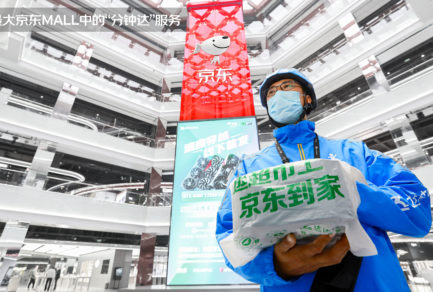Mar 20, 2020|
In-Depth Report: JD.com: A New Standard and Solution for Modern Supply Chain
by Tracy Yang and Brad Burgess
“JD.com has set a new standard and solution for the modern supply chain,” said Wang Wei, Director of the Market Economy Research Institute of the Development Research Center of the State Council of China. “As an important part of the new infrastructure, developing an information-based, digital, and smart supply chain will also further the drive toward being more information-centric, digital, and smart, ultimately contributing to supply-side structural reform. We will accelerate the transformation of China’s economy, forming a virtuous circle of national economic development.”
The story of JD.com is a tale rife with twists and unexpected surprises. The company founded by Richard Liu, Chairman and CEO, two decades ago was first and foremost a retail company. A man who unwaveringly believed in providing real products at a real price, Liu greatly respected leaders like Sam Walton, the legendary founder of Wal-Mart, and saw him as setting the benchmark and standard for the traditional retail industry. Liu had a similar vision to set an industry benchmark for China in the retail industry.
Liu said before that JD’s growth “can be explained simply: it is nothing more than making constant ground-breaking innovations to a business model to meet new customer needs and leveraging the Internet to reconstruct the supply chain system, reduce costs, improve efficiency, and ultimately, create value for consumers.”
Indeed, the China “economic miracle” has been attained through continuous – arguably, breakneck – breakthroughs. When change is the one constant, it’s imperative to lead the change or be left behind.
The Case for Change
In 2017, Liu emphasized the nature of the company’s transformation when he pointed out that JD “will leverage technology to transform the business model we built over the first 12 years to become a purely technology company.” Under this guidance, JD has continued to build its 5G network, cloud computing, big data and artificial intelligence over the past three years.
The impact of this decision cannot be overstated. The company has recently upgraded its overall brand positioning to be “a technology and service enterprise with supply chain as its core”. As JD has transitioned its business model from being a purely retail company, it has built strength upon strength, marrying technological innovation with its “asset heavy” but increasingly profitable fully owned in-house logistics business – resulting in what many recognize as the best supply chain in the business. JD’s supply chain is capable of predicting what people want before they know they want it, delivering and replenishing product across China in the midst of China’s – and, now the world’s – biggest public health crisis in over a decade; and, doing so without breaking circuits in the process. Let’s talk a little bit more about this in detail.
JD’s efforts in developing its smart supply chain and smart logistics have paid off in the fight against COVID-19, which has given rise to the recognition of JD’s role as a pioneer in the “New Infrastructure Project”: the infrastructure development underway in China supported by 5G, AI and IoT.
The sudden outbreak of COVID-19 has tested many industries in China, and the retail industry is no exception. Facing a series of challenges, such as slow production and poor logistics, JD.com relies on its core advantages in smart supply chain and smart logistics to ensure the normal supply of products at stable prices, provide fast delivery as well as transport prevention materials. In doing so, JD has played a key role in ensuring social stability at a challenging time and demonstrating the value of JD’s business model.
Unshakable strength in supply chain management
JD has been delivering products to Chinese consumers during the epidemic period, which is supported by JD’s strong supply chain management capabilities and achievements in technology innovation.
At the end of December 2019, JD Logistics’ monitoring system flagged a significant increase in mask sales in Wuhan. JD Logistics immediately prepared 70,000 masks for its couriers in Wuhan and carried out rapid replenishment and internal alerts. This “smart decision making” supported through big data laid a solid foundation for the business to take the lead in fighting the epidemic, while the smart supply chain provided an important guarantee for the rapid transportation and distribution of prevention materials to secure people’s basic needs.
In fighting the epidemic, JD Logistics centralized the smart logistics network for all products nationwide, accurately managing the transportation capacity overall, and prioritized orders sent to key hospitals in Hubei province. The network that JD Logistics had already established in Hubei also played an important role in this success. The sorting center in the Wuhan Asia No.1 was operational in Q4 2019 and was critical in ensuring Wuhan consumers’ daily needs. This particular sorting center can handle one million orders a day to meet the needs of people across central China.

To reduce human contact during the epidemic period, JD has deployed autonomous delivery robots to send products to consumers. In addition, JD has launched several other contactless delivery methods to better protect its staff and consumers.
Guaranteeing Chinese consumers’ basic needs
During the epidemic, the supply of various medical and protective equipment – such as masks, disinfectants, and hand sanitizer – was tight. JD’s smart supply chain advantages are the key to ensuring supply at stable prices of all kinds of protective medical protective equipment regarding supply, warehousing and distribution, and platform control.

JD has taken a series of measures, including working more closely with partners to provide enough daily needs for Chinese consumers at stable prices, so that they can buy products online or offline at a reasonable price whenever they want without needing to worry about inadequate supply.
JD’s digital supply chain strengths were demonstrated when cooperating with upstream suppliers. For example, CP Group’s supply of poultry, eggs, noodles, convenience meals and other foods on JD experienced an unprecedented surge in orders during this past Chinese New Year holiday season due to COVID-19. During the course of inventory replenishment, JD’s strong supply chain capacity helped CP Group coordinate vehicles, transportation, and storage effectively to overcome logistics challenges ensuring the supply of goods urgently needed by the public during the epidemic.
Building up the next generation of retail infrastructure
The epidemic has dealt a big blow to offline businesses, like restaurants, cinemas, hotels and other businesses that rely on social interaction. JD has leveraged its core competitive strength to share its capabilities across the industry and help other players overcome the difficulties during the epidemic period, such as through its talent sharing program.
The rapid development of new infrastructure in China will strongly support the development of a smart supply chain and smart logistics in China, which has always been JD’s focus over the past several years. JD will continue to make every effort to create an efficient next generation infrastructure based on technology and data-driven supply chain and logistics, which can also serve as the industry benchmark.





 This Harbin tourism boom has also spurred a surge in sales of winter apparel. JD.com’s data indicates a rapid growth in the sales of warm clothing items such as down jackets, snow boots, and thermal underwear between January 1st and 7th. The sales growth is especially pronounced in southern provinces and cities such as Jiangsu, Zhejiang, Guangdong, Sichuan, and Shanghai. Notably, tall snow boots registered a 206% year-on-year increase in transactions, while padded cotton caps and thickened long down jackets soared by 158% and 134%, respectively. Beyond clothing, travel gear has also seen a considerable uptick, with a 98% year-on-year growth in transactions for large suitcases and travel backpacks in these southern regions.
This Harbin tourism boom has also spurred a surge in sales of winter apparel. JD.com’s data indicates a rapid growth in the sales of warm clothing items such as down jackets, snow boots, and thermal underwear between January 1st and 7th. The sales growth is especially pronounced in southern provinces and cities such as Jiangsu, Zhejiang, Guangdong, Sichuan, and Shanghai. Notably, tall snow boots registered a 206% year-on-year increase in transactions, while padded cotton caps and thickened long down jackets soared by 158% and 134%, respectively. Beyond clothing, travel gear has also seen a considerable uptick, with a 98% year-on-year growth in transactions for large suitcases and travel backpacks in these southern regions. JD.ID CEO Pledges to Prioritize Supply of Daily Necessities in Indonesia
JD.ID CEO Pledges to Prioritize Supply of Daily Necessities in Indonesia



